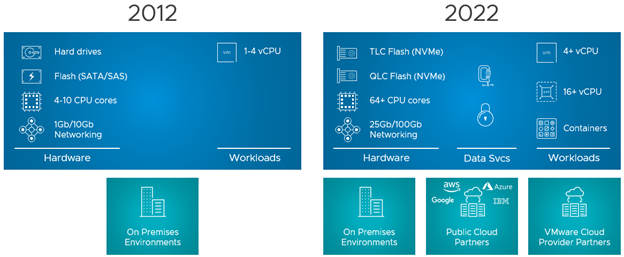One of the more exciting announcements that came out of VMware Explore 2022 over the summer was the release of vSAN 8.0. While we have seen some exciting new improvements with new vSAN releases in the past, this new release introduces a brand-new storage architecture that will provide significant performance benefits when using ultra-fast NVMe-based TLC flash devices.
With workloads now demanding more performance and IOPS than ever, NVMe has made a lot of headway into storage with now even more traditional SANs that are utilizing them in all flash configurations (Dell PowerStore for example). We will likely see concepts such as “tiering” become a relic of the past as all-flash continues to dominate in the on-prem/hybrid world.
VMware has embraced this and incorporated a brand-new storage architecture in vSAN 8.0 called vSAN ESA (Express Storage Architecture). ESA removes the need for disk groups or capacity and cache disks and has moved to one logical pool of disks utilizing NVMe only (that’s right folks, no option for standard SSD or spinning with ESA!).
The rapid evolution of NAND technologies allows for the storage bottlenecks to all but disappear as NVMe becomes larger in capacity and more affordable. vSAN was always “hindered” by having to support the legacy storage technologies and this advancement has allowed for vSAN to move into the next generation of computing and storage.

Source: https://core.vmware.com/blog/introduction-vsan-express-storage-architecture
The new architecture incorporates a new file system called LFS (or log-structured file system) which has been designed specifically to reduce overhead and cut out contention points that have existed in the original vSAN architecture to get close to near-device level speeds.
With LFS, you can now utilize RAID 5 or 6 (with erasure coding) with no tradeoff on performance (it will be just as fast as RAID 1). This will allow you to gain storage efficiency without sacrificing performance.
To support the higher bandwidth requirements for NVMe (and get as close as possible to near-device level speeds) the ESA architecture requires 25Gb networking on the vSAN level – these speeds are now becoming more commonplace in the data center for storage as 10Gb is being slowly replaced.
You can still opt to keep the OSA (original storage architecture) and upgrade your existing vSAN 7.0 deployment to 8.0 (with mixed SSD/HDD) and still take advantage of the larger write buffer limits introduced in 8.0 (applicable to OSA). An upgrade to ESA would require a replacement of the disks and the addition of 25Gb networking (if not in place now).
If you are interested in learning more about how vSAN 8.0 and ESA can enhance your data center, remove the bottlenecks, and move you into the next generation of HCI reach out to your WTG Account Executive today!

